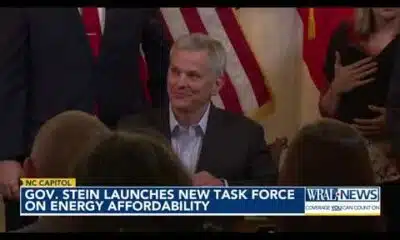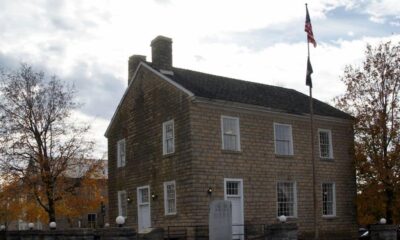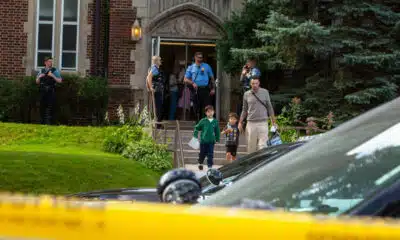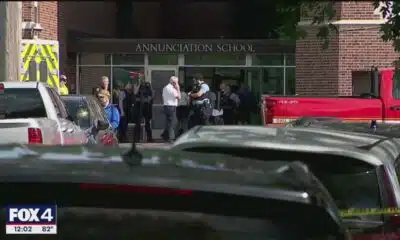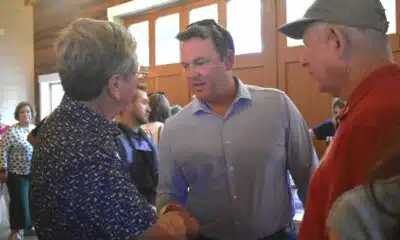News from the South - North Carolina News Feed
Is a new Fairview gun store too close to schools? Strange white lights during last weekend’s blackout? Barley’s Taproom update? • Asheville Watchdog
Today’s round of questions, my smart-aleck replies and the real answers:

Question: I hope I’m not abusing your inbox with my questions, but I have a new one that is of major interest to me and I would imagine all the parents and families living in the Fairview area. On my morning commute to take my kids to their kindergarten and elementary schools off of 74A (Charlotte Highway), I saw a sign for a new business that was going to replace the old Rust and Found antique shop, near the intersection of Charlotte Highway and Cane Creek Road. At first, I was excited to see a new business in the area, but then upon closer inspection I saw that it was a gun store. I’m not opposed to people owning guns, particularly for hunting purposes, but it struck me as alarming and upsetting that a gun store was going to be opening about a mile from our largest elementary school, Fairview Elementary, and about a half-mile from my kid’s kindergarten school, Mighty Oaks Montessori. I thought surely there must be some kind of restriction on where gun stores can open and particularly their proximity to businesses like schools, daycares, and kindergartens. As a parent, it’s already frustrating enough to have to worry about the safety of our children when they go to school, but it seems particularly cruel to serve up that reminder to parents every morning as they’re driving their kids to school.
My answer: Sir, my inbox is virtually abuse-proof, so I can assure you that you’re violating no government codes and certainly not any Answer Man standards.
Real answer: First of all, let me give the actual distances involved. The new gun shop, Mountain West Firearms, is located at 1484-A Charlotte Highway, 1.1 miles from Fairview Elementary (on Charlotte Highway), .6 of a mile from the Montessori School (also on Charlotte Highway), and 3.9 miles from Cane Creek Middle School on Cane Creek Road.
Gun shops do not fall under particularly onerous restrictions on where they can and cannot locate.
Buncombe County spokesperson Lillian Govus told me via email, “Buncombe County does not have any regulations in our local code pertaining to this matter.”
She directed me to UNC-Chapel Hill’s School of Government and a May 2023 article by David W. Owens titled, “Planning and Development Regulation, Guns Sales and Shooting Ranges.”
“Since 1994, federal law has required applicants for federal firearms licenses to certify that ‘the business to be conducted under the license is not prohibited by state or local law in the place where the licensed premise is located,’” Owens wrote. “This federal-licensing process for places selling firearms includes a zoning-compliance review.”
He also noted that in 1996, the General Assembly “established a policy of uniform state standards for a number of local regulations on guns, including restricting local zoning control of various aspects of gun sales.”
“Under General Statute 14-409.40, zoning regulations must treat the sale of firearms the same as any other commercial activity and must treat firearm shows the same as any other commercial show; more-restrictive regulations cannot be applied on the basis of firearm sales,” Owens wrote. “This law does provide some flexibility to address safety concerns near schools. It allows zoning regulations to require a special use permit for any commercial activity within a set distance from a school as well as adoption of a permit standard that the uses must not pose a danger to the health, safety, or welfare of those attending the school.”
The federal Bureau of Alcohol, Tobacco, Firearms and Explosives does not set a distance requirement on gun stores or those holding a federal firearms license and schools.
The ATF website states: “Generally, it is unlawful for any individual to knowingly possess a firearm within a school zone. A school zone is defined as being within a distance of 1,000 feet from the grounds of a public, parochial or private school. This prohibition does not apply to the possession of a firearm on private property not part of school grounds such as a [Federal Firearms License’s] business premise (e.g. commercial storefront, residence or driveway).”
I stopped by the store and talked with executive manager Robert Wareham and his wife, Jennifer Holschuh, the chief operating officer and general manager. The store is not fully open, but they plan for a soft opening June 1 and a formal grand opening over July 4.
Wareham said the current location will be temporary, as they plan to build a larger facility near Charlotte Highway and I-40, off of Gashes Creek Road.
“I have a two-year lease (here), with an option for a third from the owners here,” Wareham said. “They were thrilled to have us come in, and the reception from the public here, it’s just been overwhelming.”
He suggested my reader has “the typical liberal disconnect” when it comes to guns.
“No criminal is coming to a gun shop to buy,” Wareham said, noting that they will store their guns in a vault at night to prevent theft. “We don’t want illegal guns on the street any more than (my reader) or anyone else.”
Wareham said they’ve been “inundated by goodwill,” and he suggested my reader is in “the extreme minority.” He said even before they’ve opened they’ve gotten a lot of inquiries, but not necessarily about buying guns.
“The No. 1 thing they’re looking for is training,” Wareham said. “They want to feel more comfortable and safer handling their firearms.”
The building is set up for a small “academy” in the back for classes, including “weaponless” self-defense classes. They will teach Taser courses, as well as offer ham radio classes.
Wareham said they’re in full compliance with laws and regulations.
“This will not endanger (people),” he said. “It’s not like we’re putting guns out here on display that people can get at. They’re secured. They’re unloaded.”
Wareham says they plan to stay in the current location while building the new facility, which will feature a shop, meeting space and 16 range lanes for shooters. The facility will be called “The Range at Mountain West.”
He said he believes there’s a strong demand for another firing range in town, as the nearest one is at On Target in south Asheville, off Sweeten Creek Road.
Besides complying with all federal laws, Wareham said, they also will not sell to anyone that they find suspicious.


Question: (John Boyle speaking here) During the power outage last weekend, a friend of mine about a mile away texted me to say he and his wife and son were sitting on their back porch and kept seeing “strange lights flying over.” They were flying in the same pattern, moving much faster than planes and generally moving from west to east. In all, they counted about 30. He also sent me a video in which I could see a couple of very fast-moving white lights. I also spotted one while sitting in my backyard. Between the electromagnetic storm theory about the outage, which I wrote about Tuesday, this adds another layer of weirdness. We both suggested we’re being probed by aliens, or maybe China. And we both agreed it would make a good Answer Man question. So, just what the heck were those white lights?
My answer: Just for the record, I’m writing this from the Andromeda Galaxy on a very fast moving spaceship. Lots of craft beer and burgers, so I’m pretty sure these are friendly aliens. I’m just glad they didn’t say, “Take us to your leader.”
Real answer: UNC-Asheville physics and astronomy professor Britt Lundgren took this one on.
“I can say with some confidence that the string of fast-moving white lights was a recently launched set of Starlink satellites (providers of SpaceX’s satellite internet service),” Lundgren said via email. “Starlink satellites are launched in groups, and SpaceX launched a group of 26 on May 16.”
We were all sitting in the dark last Saturday night, May 17, so that tracks. The launch occurred in California.
“Soon after launch, Starlink satellites resemble a line or chain of unblinking white dots in the sky,” Lundgren said. Their brightness is caused by sunlight reflecting off their surfaces, which makes them brightest soon after sunset and before sunrise.
”“They slowly separate from each other in low-earth orbit and then become more spread out and fainter as they find their positions in higher orbits.”
We should’ve known Elon Musk was to blame!
Lundgren noted that more than 8,600 Starlink satellites are in orbit now, “and a couple of them are almost always above our horizon.”
“They’re only designed to last for about five years, after which point they de-orbit and burn up in the Earth’s atmosphere,” Lundgren said. “So, Answer Man readers should expect to see many more artificial ‘shooting stars’ in the coming years!”
I’ve seen the full-blown Starlink chain of blinking lights twice, in Fletcher and Yellowstone National Park. Both times, it was pretty awesome.
Of course, there is a downside to the satellites falling back to Earth.
“Under certain conditions, this space junk may not completely burn up and dense pieces can make it to the ground,” Lundgren said. “A report by the U.S. Government Accountability Office in 2022 quoted a study that predicted ‘having a total of 15,968 satellites in low-Earth orbit by 2030 with 2,413 reentries per year could result in approximately a 1:4 human casualty risk” (i.e., one human casualty for every four reentering satellites)!”
Yikes! Lundgren put it this way:
“So I would say, it’s a prettier sight to see them going up than coming down!”
Agreed.

Update on Barley’s Taproom: In early April I fielded a question about the Barley’s Taproom & Pizzeria, as the beloved Asheville restaurant had been closed since the fall, after Helene devastated the area and foot traffic dried up.
Katie Hild, Barley’s marketing director, said then they hoped to get the upstairs back open soon. Well, that day came May 16.

Barley’s Upstairs has officially reopened at 42 Biltmore Ave.
“We’ve given the Upstairs a refresh — but don’t worry, it still has that old-school Asheville vibe you know and love,” a news release said. “The space has been spruced up with beautiful new lounge seating, a brand-new cocktail menu, unique liquor and wine offerings, and even a shuffleboard table. And yes, pool, darts, and one of the best beer selections in town are still going strong.”
Hild noted that reopening one part of Barley’s, which has been in operation for 31 years, “feels like a meaningful step forward” for the community.
“While the downstairs pizzeria and taproom remain temporarily closed, we’re looking ahead with optimism and hope to welcome folks back to the full Barley’s experience in the near future,” the release said.
Barley’s Upstairs is open from 4 p.m. to 1 a.m., Thursdays through Sundays.
Asheville Watchdog welcomes thoughtful reader comments on this story, which has been republished on our Facebook page. Please submit your comments there.
Asheville Watchdog is a nonprofit news team producing stories that matter to Asheville and Buncombe County. Got a question? Send it to John Boyle at jboyle@avlwatchdog.org or 828-337-0941. His Answer Man columns appear each Tuesday and Friday. The Watchdog’s reporting is made possible by donations from the community. To show your support for this vital public service go to avlwatchdog.org/support-our-publication/
Related
The post Is a new Fairview gun store too close to schools? Strange white lights during last weekend’s blackout? Barley’s Taproom update? • Asheville Watchdog appeared first on avlwatchdog.org
Note: The following A.I. based commentary is not part of the original article, reproduced above, but is offered in the hopes that it will promote greater media literacy and critical thinking, by making any potential bias more visible to the reader –Staff Editor.
Political Bias Rating: Centrist
This content maintains a neutral, factual tone in its reporting, presenting multiple perspectives around the topic of a new local gun store near schools without overt editorializing. It provides detailed legal and regulatory context, includes voices from official sources as well as the business owners, and addresses community concerns. Additionally, the segments about Starlink satellites and the local bar reopening serve as impartial, community-focused updates. Overall, the article neither promotes a strongly liberal nor conservative viewpoint but favors an objective, balanced approach typical of centrist local journalism.
News from the South - North Carolina News Feed
Governor Josh Stein launches new task force on energy affordability
SUMMARY: Governor Josh Stein has launched a bipartisan energy policy task force to address rising power bills in North Carolina amid surging demand from data centers and rapid state growth. The group includes regulators, lawmakers, utilities, major companies like Duke Energy, Amazon, Google, Toyota, and clean energy advocates. Its main goal is to keep energy affordable while balancing costs between households and large industrial users. Stein emphasized learning from other states on cost-sharing for new power infrastructure. The task force also aims to protect economic development, warning that federal clean energy cuts could risk 50,000 jobs and increase bills by up to 18%.
Your power bill could get even higher, and Governor Josh Stein said the state needs to act. On Tuesday, Stein announced a …
News from the South - North Carolina News Feed
Spending on classrooms by NC teachers among highest in US
Teacher pay has been a long and storied battle in North Carolina, with the state consistently ranking among the lowest teacher salaries in the country. But while educators are often pinching pennies and stretching dollars to make ends meet, a new report from CouponBirds shows North Carolina teachers are spending an average of $1,632 out of their own pockets to supply their classrooms.
That’s the second-highest in the country according to the study, just $5 less than Pennsylvania teachers. It’s a 22% increase from the average amount NC teachers spent in 2024 and is well above the report’s national average of $1,021.
President of the North Carolina Association of Educators Tamika Walker Kelly told Carolina Public Press that teachers tend to spend the most money on consumable products like notebook paper, pencils, tissues and cleaning wipes. While many teachers will ask parents to purchase these supplies for their children — or even for communal use — at the beginning of the school year, Kelly noted that families are often experiencing economic hardships themselves.
[Subscribe for FREE to Carolina Public Press’ alerts and weekend roundup newsletters]
“Educators stand in the gap most of the time to provide resources for students and families who cannot afford them,” she said. “And we have to turn over those resources throughout the year — not just at the beginning of the year, but throughout the duration of the academic season.”
It’s a national trend for teachers to post their “classroom wishlists” online in hopes good Samaritans will purchase some of the items. Kelly said crowdfunding for supplies is nothing new to NC teachers, but it has become more routine as resources have shrunk.
“Unfortunately, that has become more commonplace, but it shouldn’t be because we need our North Carolina legislators to invest in the basic resources that our students need in order to thrive,” she said.
“We should not be dependent on crowdfunding our classrooms when we have a constitutional obligation to make sure that every student has the resources that they need here in our state.”
In the wake of slimmed budgets and decreased resources, teachers often have to get creative to make ends meet in the classroom.
Kelly told an anecdote of a teacher who cut composition books in half to double the amount of notebooks she was able to distribute to her students. A more common hack is to wrap a rubber band around hand sanitizer dispensers. This limits the amount that comes out of the bottle, prolonging the bottle’s life span, Kelly said.
Many educators already work second jobs to pay for their supplies each year or simply to sustain their lifestyle, Kelly said. Additionally, teachers can also be parents who have to purchase supplies for their own children on top of stocking their classroom.
“For our educators to be spending as much money as they do to supply their own classrooms, in contrast to the data that shows that we are one of the lowest-paid states in the nation for educator pay really highlights the dissonance and the really deep investments in care that our educators take into putting into their classroom versus the lack of care that our lawmakers are putting in to making sure that we continue to retain these educators,” she said.
Finding solutions for classroom spending
Madeline Blobe is the executive director of the Chapel Hill-Carrboro Public School Foundation, a nonprofit that raises additional funding for schools in the area.
The organization funds scholarships, innovative projects and teacher awards, as well as offering a Teacher Supply Store for educators to “shop” for classroom supplies. They work closely with the East Chapel Hill Rotary Club, which does 85% of the fundraising for PSF each year.
The supply store is meant to defray some of the financial burdens teachers face when it comes to stocking their classrooms by spending out of their own pockets, Blobe said. This year, more than 1,100 teachers in the district will be able to “purchase” $50 worth of supplies from the store for free of charge. Available items range from two composition books for $1 to an electric pencil sharpener for $30.
“If you’re at the store, you feel it — what this means to teachers, how happy it makes them all. It seems like a little thing, but it really is a big thing to them,” Blobe said.
“They’re obviously devoted to their jobs or they wouldn’t come to work. They have very hard jobs. They’re not paid well. It’s obviously a passion for them, but it is definitely the generosity of our community that means a lot.”
Although PSF is a nonprofit organization and cannot lobby for legislation or political causes, Blobe said she does feel it is her responsibility to keep her donors and community informed about the state of education resources.
While generosity from the community is something teachers undoubtedly appreciate and sometimes even depend on, it is ultimately the state’s responsibility to fund public schools and ensure access to a quality education, Kelly said.
That starts with investing in students and increasing the access educators have to resources, as well as raising teacher pay for both new and veteran teachers, she said.
“We believe that dual investment, both in the overall funding of our public schools but also investing in comprehensive educator pay increases, will help us address this issue so that we don’t continue to face it in the future,” Kelly said.
National trends
Executive Director of AdoptAClassroom.org Ann Ruhr Pifer said the organization was designed to relieve the burden of teachers spending out of their own pockets. In North Carolina, 766 teachers are currently seeking support from the organization, which supplied 680 classrooms during the 2024-2025 school year.
Teachers create a page on the website detailing their classroom needs and what they hope to spend any donated funds on. Donors can decide to donate to individual teachers, a school or directly to AdoptAClassroom.
Any donations that a teacher receives goes into an account managed by the organization and can only be spent on an e-commerce marketplace containing educational and office supplies vendors. No money changes hands, and items are shipped directly to the teacher’s school.
Similarly to PSF, AdoptAClassroom sees its role as meeting the immediate needs of teachers across the country. But it’s not about simply choosing to focus on charity or legislation, Pifer said.
“Today, those funds can get right into the classrooms. Changing public education funding is a bigger issue,” she said. “And when I’m talking to potential donors or speaking to groups, I always say it’s not an ‘either, or’ — it’s a ‘yes, and.’”
Since the COVID-19 pandemic, AdoptAClassroom saw increased awareness from donors and teachers alike. Pifer said she thinks the pandemic drew attention to how much teachers do, so people felt more inclined to offer help. But teachers also struggled more and sought additional support.
AdoptAClassroom has conducted its own studies on teacher spending, and it found that teacher spending has increased 50% in the last 10 years. It’s clear that the burden has increased for teachers, and many are concerned that inflation is playing a role, Pifer said.
Not only does inflation impact the price of items directly, but it creates a domino effect across school districts.
“In talking to school principals, I realized that it also has a significant indirect effect. So inflation, and cost increases driven by many things, is increasing the cost of janitorial supplies, services that the school depends on, supplies and services just to run the school,” Pifer said.
“So now the principal’s budget is strained too, and maybe they used to be able to give teachers $200 for classroom supplies. Maybe now they can only give them $100 or maybe nothing. It may be gone, because the inflation pressure on the school budget is significant.”
A viral video recently sparked controversy when a parent voiced concerns online about her experience at her child’s teacher’s classroom at an open house. She was underwhelmed by the classroom, specifically the empty bins and lack of a rug.
Teachers responded in droves, explaining how they are largely expected to supply and decorate their rooms by spending their own time and money. So while many teachers are focused on essential supplies, there is often still an expectation for a decked-out classroom.
Blobe said decorative items, like soft lighting fixtures and posters, tend to fly off the shelves quickly at the Teacher Supply Store when they are lucky enough to have them available. Teachers also like to purchase items like rugs or comfortable seating options through AdoptAClassroom, Pifer said.
Kelly said she is concerned about the increasing financial burden on teachers contributing to teacher burnout. Some teachers are getting to a point where they have to make tough decisions and opt not to stock their classrooms by spending as heftily as they typically would, she said.
In the worst cases, teachers are leaving the classroom entirely. Sometimes they’ll leave to work for education-related companies where they can still utilize the same skills. Other times, they’ll step away from education altogether. Kelly cited the “educator to real estate pipeline” as one example.
“Many educators are choosing to leave the profession or are being pushed out of the profession because it is no longer sustainable for them and their families, and that is why we are continuing to deal with the educator shortage here in North Carolina,” she said.
“And until it is adequately and properly addressed through the North Carolina General Assembly, we’ll continue to see educators be pushed out of a career that they love to do, into the private sector, or into other states that compensate their educators more.”
This article first appeared on Carolina Public Press and is republished here under a Creative Commons Attribution-NoDerivatives 4.0 International License.
The post Spending on classrooms by NC teachers among highest in US appeared first on carolinapublicpress.org
Note: The following A.I. based commentary is not part of the original article, reproduced above, but is offered in the hopes that it will promote greater media literacy and critical thinking, by making any potential bias more visible to the reader –Staff Editor.
Political Bias Rating: Center-Left
This content emphasizes challenges faced by public school teachers, particularly low pay and the burden of self-funding classroom supplies, while advocating for greater state investment in education. It highlights systemic issues and includes calls for legislative action to increase funding and teacher salaries, which aligns with center-left perspectives prioritizing public sector support and social investment. The tone is sympathetic to educators and critical of insufficient government funding, but it remains measured and fact-based without heavy partisan rhetoric.
News from the South - North Carolina News Feed
Frank Porter Graham and the legacy of Social Security
SUMMARY: Ninety years ago, the U.S. Congress passed the Social Security Act, establishing federal old-age benefits and support for vulnerable populations. Frank Porter Graham, former UNC president and brief U.S. senator from North Carolina, played a crucial role in its creation, chairing the Advisory Council on Economic Security under FDR. Graham championed racial equality, labor rights, and economic justice, viewing economic security as a moral imperative essential to American liberty. Despite compromises in the law’s final form, his vision laid a foundation for social progress. His legacy encourages renewed commitment to social justice amid present challenges, highlighting North Carolina’s tradition of humane progress.
The post Frank Porter Graham and the legacy of Social Security appeared first on ncnewsline.com
-
News from the South - Arkansas News Feed6 days ago
New I-55 bridge between Arkansas, Tennessee named after region’s three ‘Kings’
-
News from the South - Texas News Feed4 days ago
DEA agents uncover 'torture chamber,' buried drugs and bones at Kentucky home
-
News from the South - Louisiana News Feed7 days ago
Families with citizen children deported by ICE sue Trump administration
-
News from the South - Georgia News Feed7 days ago
Bookman: Here’s how Georgia’s 2020 election crisis will factor into 2026 GOP campaigns for governor
-
News from the South - Missouri News Feed6 days ago
Missouri settles lawsuit over prison isolation policies for people with HIV
-
News from the South - Virginia News Feed6 days ago
Erin: Tropical storm force winds 600 miles wide eases into Atlantic | North Carolina
-
Our Mississippi Home6 days ago
Vardaman: The Sweet Potato Capital Serving Up Love, Tradition, and Flavor at Sweet Potato Sweets
-
Local News5 days ago
Florida must stop expanding ‘Alligator Alcatraz’ immigration center, judge says





